Our recommendation for most people is Bluehost because it gives you everything you need to start a WordPress website, even if you’ve never built one before. Get started for $2.95 per month today!
Building a website from scratch used to be hard. Not anymore. In fact, the best website builders turn you into a web designer overnight, even if you’ve never built one before. All you do is pick a stunning template and add your personality to it. See for yourself in our review of the best website builders on the market.
The 8 Best Website Builders
- Bluehost – Best website builder overall
- Web.com – Best website builder for beginners
- Shopify – Best for selling products and services
- Wix – Best balance of ease of use and customization
- Hostinger – Best for keeping website costs low
- Squarespace – Best website builder for creators
- Weebly – Best website builder for solopreneurs
- GoDaddy – Best for building a website from your phone
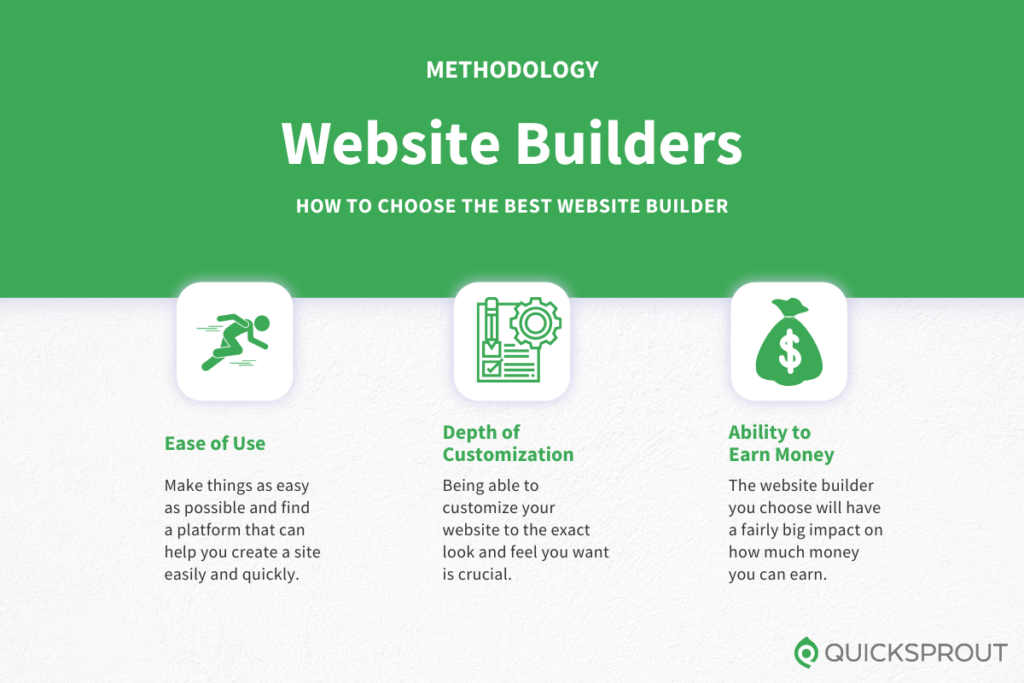
Website builders have gotten so much better over the years. Today, you don’t have to struggle with getting a site online or updating it to keep up with changing times.
To find out which ones were the most helpful, the Quicksprout research team got in touch with people who used these website builders for their business. Keep reading to get the full story.
Bluehost – Best Website Builder Overall
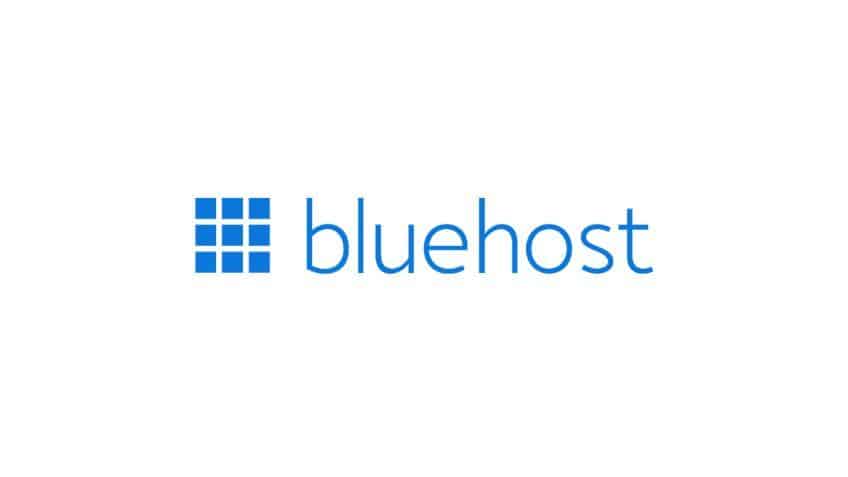
WordPress is the most popular way to build a website in the world–but you need your own hosting. Using Bluehost WordPress Website Builder is our recommendation for launching your site.
A quick disclaimer: WordPress is the content management system (CMS) we use here at Quicksprout. So, we can personally attest to how great it is.
We’re not alone, either. If you use WordPress, you join the likes of Vogue, Bloomberg, and even Beyonce, who use it as their CMS.
Don’t just take our word for it, though; our users all thought the same thing.
“With no knowledge of WordPress when I started, it was a bit of a steep learning curve, but I figured everything out quickly enough,” said one user. “WordPress is very intuitive, and if you can’t figure something out, you just have to Google it or check on YouTube, and you will likely find an answer.”
Not only is it highly customizable, but it’s also scalable. This is a CMS that can grow as large as you want or be scaled back to as small as you want.
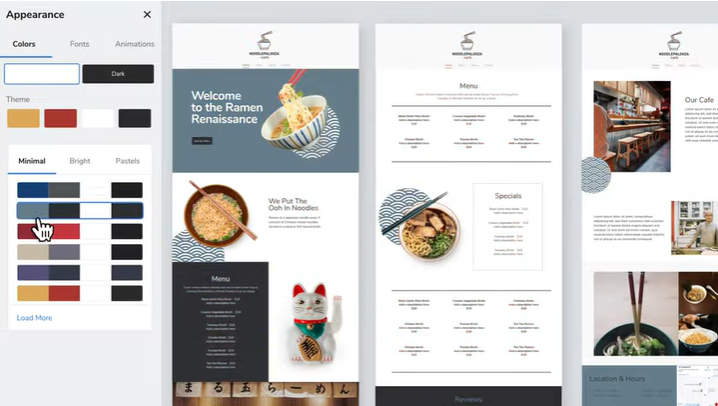
Another user loved how flexible WordPress was. That’s because it’s an open-source application, so the back-end code is widely available—allowing developers and creators to make their own themes, widgets, and plugins for the CMS.
That means there are a ton of different ways you can mix and match plugins and themes out there. And, if you want to get your hands dirty, you can jump into the backend yourself and customize your site to your heart’s desire.
WordPress also has more than 11,000 themes. Many of them are free, and some of them are paid.
Our recommendation: Go with a paid one if you can afford it. One of our users paid for their theme, customized the heck out of it, and made it their own.
The benefit of doing this is that your website will easily stand out from the rest. When you go with one of the popular free themes, it’s just going to look like hundreds of other WordPress websites. However, if you put in a little work—and a little money—you’ll end up with a site that’s uniquely you.
All of our users built their sites exclusively to draw in leads, customers, and sales. The CMS allowed them to do so with easily integrated ecommerce functions, as well as powerful SEO tools such as Yoast to help capture organic traffic.
“I was able to monetize my website using affiliate marketing,” one user told me, “along with infoproducts like ebooks and minicourses once my audience got big enough.”
This user runs a genealogy website dedicated to helping people connect with family members. They were able to use their ancestry-specific blog along with a popular newsletter to build a loyal community of readers (and, therefore, customers).
“One thing that helped with that was creating an email subscriber list and a newsletter using the Mailchimp plugin,” they said. “It’s a must-have if you want to monetize your blog.”
Building a Website with WordPress
Like we said, this is what we use here at Quick Sprout—so we’re well-versed in WordPress.
However, there is a little bit of a learning curve for new beginners. The backend dashboard can frankly be overwhelming. But the good news is that after just a little bit of exploring and experimenting, you’ll get the hang of it in no time.
From your dashboard, you’ll be able to do everything from creating new pages for your site to crafting blog posts to downloading new themes, plugins, or widgets.
The blog and page editor uses WordPress’ proprietary Gutenberg interface: a user-friendly blog and page creator that leverages drag-and-drop tools to help you create the page you want.
It’s not the What You See Is What You Get interface that Wix or Web.com offer—but it’s close. If you want to see what your page or blog post looks like in the final product, you’ll have to click on the Preview button at the top of the editor. That’ll open up a new tab with the preview of your page/post.
It’s much, much more intuitive than its old editor—and will give any other WYSIWYG editor a run for its money.
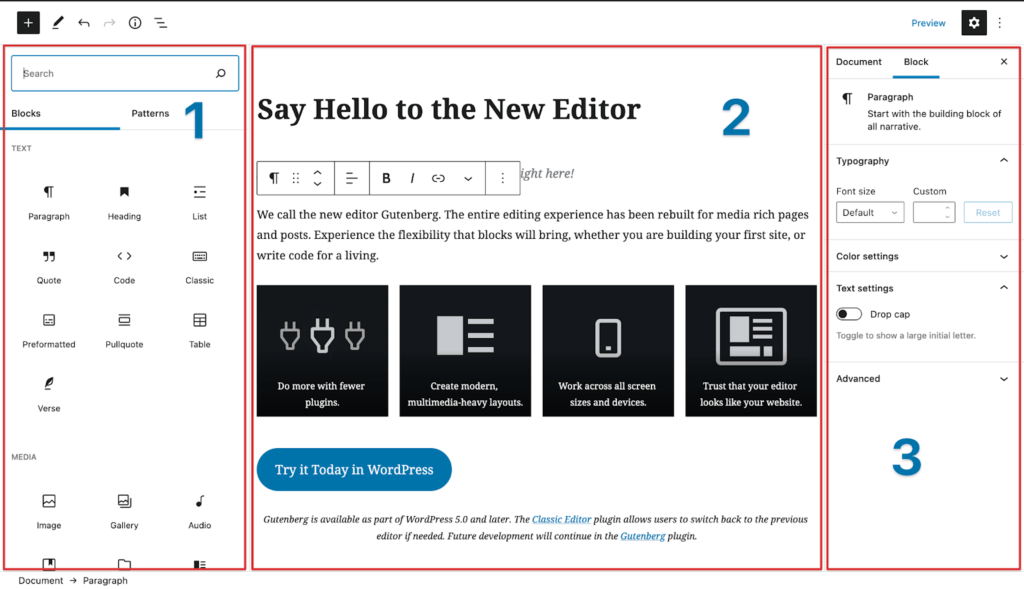
As mentioned before, WordPress is scalable. If you want to build a big website with a ton of different assets, you can choose the right plugins to help. You can hire a developer (or yourself if you have PHP skills) to jump in the back end and build exactly what you need.
“WordPress gave me everything I needed to create the blog I wanted,” one user told us. “It gave me an easy interface to post my blogs, as well as everything I needed or wanted in my blog: a subscription box, an author area; just the look I wanted and the flexibility to change things as needed.”
We highly recommend starting small when it comes to plugins. Our favorite plugin is Yoast SEO. It’ll help you make your page, and blog posts rank better on Google search results by helping you find optimization opportunities in your content.
Choosing a Host
If you want to build a website with WordPress, they give you two options:
- Build it for free. This means your site will be hosted by WordPress. We don’t recommend this for a number of reasons. One of the obvious ones is that you’ll have to have a WordPress-branded subdomain (e.g., quicksprout.wordpress.com). Note: WordPress.com is their free, fully hosted version. If you want the self-hosted option (which we recommend), you’ll have to go with WordPress.org.
- Host it somewhere else. By hosting it elsewhere, you’ll get access to more resources and (potentially) a free unbranded domain name. This is where WordPress.org comes into play.
We have a lot more information about this in our article about the best web host and best web hosting for WordPress—but the short answer is to choose Bluehost.
It’s one of the most popular web hosts out there. It’s also our favorite.
Every Bluehost plan comes with one-click WordPress installation, allowing you to easily create a website using the CMS once you sign up.
Each plan also comes with a free domain name registration too. In one fell swoop, you’ll be able to get a great domain, set up powerful and affordable web hosting, and create your WordPress site. Triple win!
All of our users surveyed used the powerful combination of WordPress with Bluehost. “I’m still using Bluehost after four years for most of my sites,” said one user. “It’s great for beginners due to how the pricing model is structured.”
Bluehost offers rock-bottom promotional pricing starting at just $2.75 per month.
Every Bluehost plan comes with 24/7 customer support. You’ll be able to email them directly, and they’ll help solve your issue as soon as possible.
That was the case for one of our users when their website crashed—but they said, “I contacted their chat support, and they were able to identify the issue (a broken plugin) and fix it immediately. [I’m] very grateful for that.”
They’ll also help you migrate to their host if you’re coming from a different hosting service. This can easily be the biggest headache for any website manager—but Bluehost makes it a snap.
“The website migration was unbelievably easy!” one user told me. “And I really prefer the portal at Bluehost compared to the old place, plus the service is better for me.”
Cons of WordPress’s Website Builder
When it came to the drawbacks, our users agreed on one thing: It’s not the most beginner-friendly website builder.
In fact, they each told us about their frustrations when using the CMS for the first time. One user said, “I don’t like how it does take a bit of a learning curve to use. Sometimes I’d like to have my hand held more through the [website creation] process rather than having to look up a bunch of YouTube how-to videos to learn how.”
The dashboard is complex at first look. Once you learn it, you’ll be able to jump into the backend of any WordPress website and know how to get around with ease. This can be a valuable skill set to have—and one that employers frequently look for.
Still, this isn’t going to be the website builder for you if you’re looking to easily create a website out of the box with little to no site-building experience or knowledge needed. For that, we recommend you look towards Wix instead.
But if you’re willing to put in the work, learning even just the basics of WordPress can result in a massive return on investment. Not only will you be able to create a fully customized website, but you’ll have a valuable skill employers definitely look for.
Another thing to mention is that WordPress doesn’t have the most comprehensive support system. “I wish there was a help desk that you could contact either by email or chat,” one user opined.
In fact, the only option WordPress offers for support is a forum where you can pose questions or bring up issues you’re having with your site.
We decided to jump in and test it out and posted a question about a fake issue related to the website. It took about two hours before we received a reply. While the answer was comprehensive and answered the question, that was still a long wait before it was answered.
If you have a business that relied on that income to keep the lights on, those two hours could represent your livelihood. We expect help faster than that.
Bluehost Pricing
Bluehost’s website builder for WordPress comes standard with its web hosting packages. Rates start at just $2.95 per month with an annual contract.
If you’re planning to use Bluehost’s site builder to create an ecommerce shop using WordPress and WooCommerce, plans start at $9.95 per month. Either way, you’re getting the lowest price out of all the other website builder’s on our list.
Why We Recommend Bluehost’s Website Builder
WordPress is the most popular website builder on the planet, and it’s not an accident.
The users we spoke with liked how easily they were able to monetize their blogs to turn their websites into income-generation engines.
While there is a learning curve, once you get the hang of it, we promise you won’t look back. By the end of it, you’ll have a website that is endlessly customizable—and it’ll be able to grow as big as you or your business gets.
That means if you’re creating a blog for your passion, and the blog grows a big audience, you’ll be able to turn the same WordPress blog into a website that generates revenue for you from your audience.
Bottom line: It’s going to take a little bit more elbow grease, but once you create a WordPress website, you’ll have a customizable website that you can make into whatever you want it to be. Couple that with Bluehost, and you’ll be able to do so easily in one fell swoop.
Web.com — Best Website Builder for Beginners

If you want the absolute easiest way to get a website live, Web.com is the way to go. It’s straightforward, streamlined, and refreshingly simple compared to other options on our list. You won’t find advanced customization or hundreds of features–which is perfect for beginners who don’t want to feel overwhelmed.
There are more than 150 responsive templates you can use to get started. All you have to is update the colors, fonts, text, and images to match your brand. It truly takes just a few minutes to build an entire professional-looking website.
There are even free marketing tools, including a QR generator, an AI copywriting tool, a lightweight CRM, and a basic photo editing solution.
Over time, you can scale up to higher tiers to add more features, like an online store, appointment scheduling, email marketing, analytics, and more. You even have the option to cross-sell products on marketplaces like Facebook, Instagram, Amazon, and Etsy, too.
Building a Website with Web.com
The easiest way to get started is with one of Web.com’s 150+ free templates. There are tons of options for various industries, including hospitality, photography, fashion, editorial, fitness, and more. Regardless of the type of site you want to create, there’s a template for you.
All of them are responsive and professionally-made so you don’t have to worry about starting from scratch.
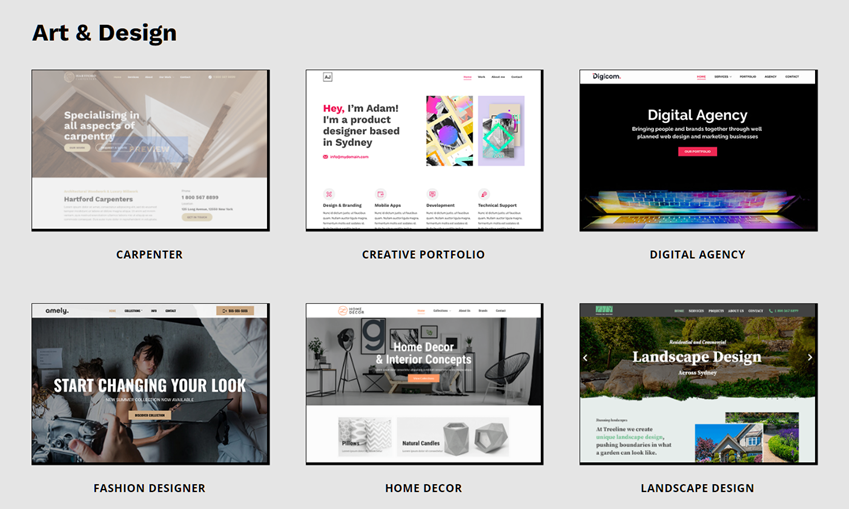
Once you choose your starting point, you’ll be able to use Web.com’s drag-and-drop editor to make changes, update images, add your own content, update colors and fonts, and truly make your website your own.
The editor’s incredibly easy to use–it’s truly streamlined to make the website building experience as easy as possible.
Aside from building and designing your website, all Web.com plans include a free domain name for the first year, so you get everything you need to go live in one beginner-friendly package. There’s even a free AI copywriting tool on most tiers to help you get started as fast as possible.
Tradeoffs with the Web.com Website Builder
One of the biggest tradeoffs with website builders in general is that you can’t move your website somewhere else. If you decide you want to use a different platform later, you’ll have to rebuild everything from scratch. It’s not that big of a deal if you have relatively simple needs, but if you’re serious about starting and growing your website, WordPress with Bluehost is truly the better option for this reason alone.
With Web.com in particular, it’s built specifically for beginners–you’ll appreciate how easy it is to use at first. But you may find yourself feeling limited by the lack of customization, advanced features, and flexibility.
You won’t be able to fine-tune the details like you would with other options on our list.
Because of that, many Web.com websites tend to look similar to one another. Again, this isn’t necessarily a major dealbreaker, but it is something to know before you go down this path.
Another downside of Web.com is that its domain names, while free for the first year, cost three times as much–$37.99 per year–as traditional domain registrars. So, you’ll get a much better deal if you move your domain elsewhere after your free year is up.
Lastly, Web.com’s website builder is more expensive than traditional hosting options like Bluehost. With that said, it’s significantly cheaper than other website builders on our list, so you’re definitely getting a lot of value at a decent price.
Web.com Pricing
Web.com has four website builder plans to choose from, including:
- Website – starting at $4.95 per month
- Website + Marketing – starting at $7.95 per month
- Online Store – starting at $13.95 per month
- Online marketplaces – starting at $19.95 per month
The prices listed are for an annual agreement and all of them include a free domain name for the first year, free domain privacy, a free SSL certificate, 24/7 customer support, and professional email accounts. . You can expect to pay up to 70% more and forego a free domain name if you go with monthly billing instead.
Sign up for less than $5 per month to get started with the most affordable website builder on our list.
Why We Recommend Web.com
Unlike other website builders that try to cater to everyone, Web.com focuses solely on beginners. It truly does everything it can to simplify the process and bring website building capabilities to the masses.
It’s hands-down the easiest way to get your website live, even if you’ve never built a website before.
Plus, it has multiple tiers so you can add more functionality to your website as your needs and skills evolve. Things like appointment scheduling, an online store, email marketing, and website analytics are ready for you whenever you are.
Bottom Line: If you want the easiest route to a published site, go with Web.com.
Shopify – Best for Selling Products or Services

Shopify is our top recommendation for companies that need a way to sell on their website. Sell products, book appointments, schedule deliveries–it’s all incredibly easy.
You can certainly do all this with other website builders, but ecommerce is Shopify’s strong suit. No other website builder will be as easy or as powerful.
It’s a true all-in-one platform: website, online store, payment processor, order fulfillment, and marketing tools. If Shopify doesn’t have a built-in feature to do what you need, it offers the most diverse app marketplace in ecommerce.
Start with any of the more than 100 ecommerce website templates. Tweak a few important elements to make it on-brand, and then start adding inventory. You need not be a tech whiz to make your first buck on Shopify.
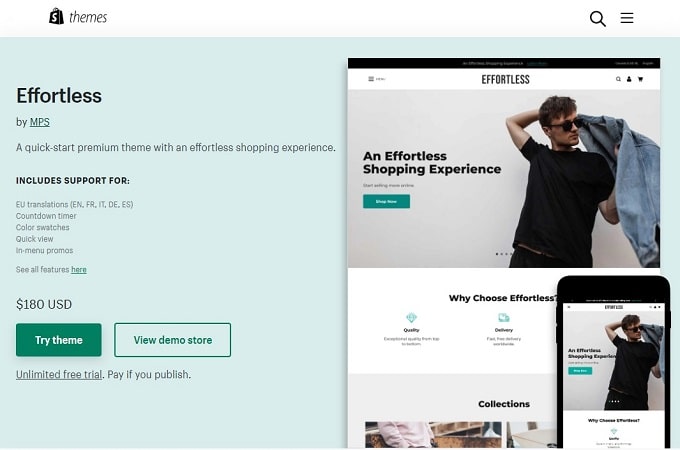
Shopify has very few limits. You can sell as many items, styles, and varieties as you like on any channel. Shopify makes it easy to impress customers who visit your page, giving them a polished online shopping experience with minimal work on your end.
Building an Ecommerce Website With Shopify
Most people will want to start with one of the online store templates. There are 11 free options, so don’t worry about having to spend more to get started.
By the time you add your content and images to the template, it already looks like a professional online storefront.
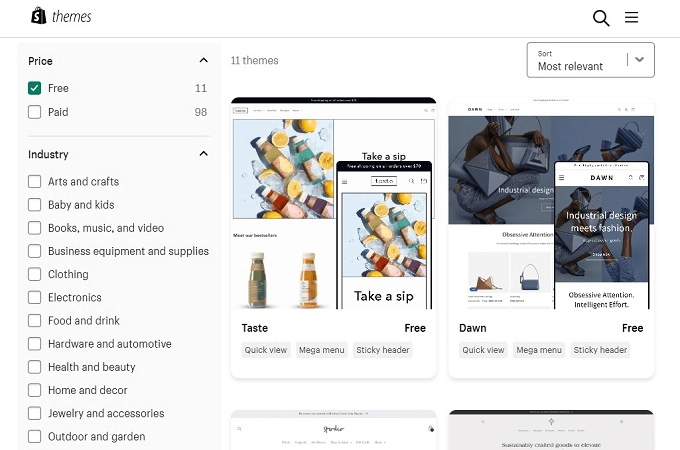
The best part about working within the online store templates from Shopify is that all your products are going to look great on a mobile phone. There are no extra plugins to install–your store will look great no matter how people are visiting it.
In terms of driving traffic to your site, Shopify lets you sell on Facebook, Instagram, Twitter, TikTok, and more. You can create on-brand content that looks like it belongs in each social network. You can also start selling on Google, eBay, and Walmart Marketplace with a few clicks.
No other platform has the ability to sell on as many different channels as Shopify. You receive email marketing and marketing automation tools that are built into the platform, too. Everything you need to get the word out is part of the package.
And keeping track of sales is no problem. Shopify gives you a clear dashboard to track every aspect of your online store.
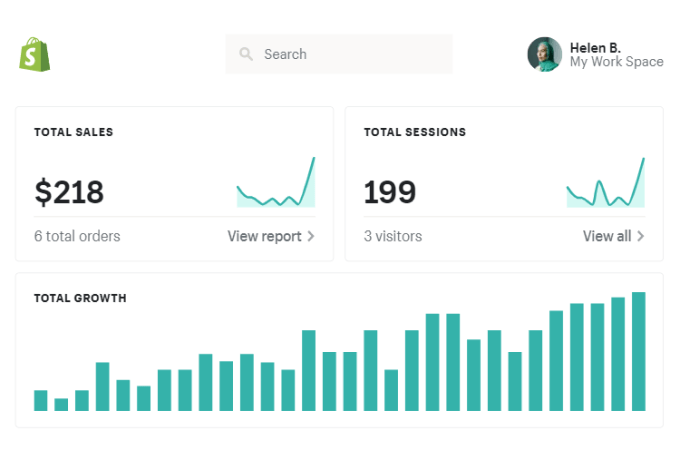
Running an ecommerce store isn’t rocket science–you just have to make good decisions based on what’s working and what’s not. Shopify puts all the critical information at your fingertips, updated in real time, so you can always choose the best path forward.
As we mentioned, you’ll have access to Shopify Payments to use as a secure credit card processor. You can connect Shopify with other payment gateways, but there are third-party transaction fees.
Using SEO with Shopify
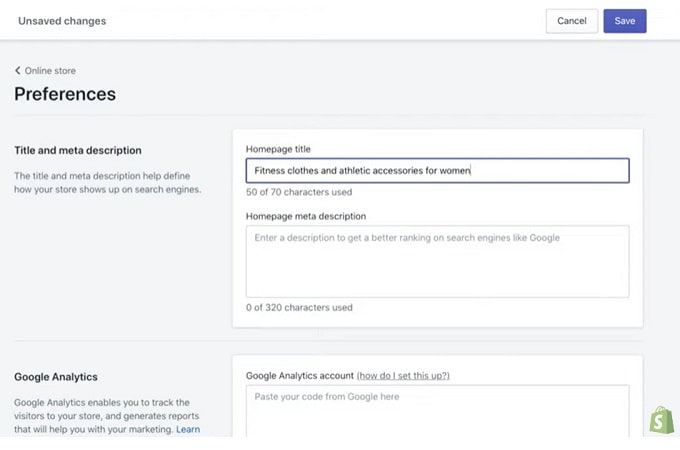
When building a new online store, drawing in customers is perhaps your biggest challenge. We mentioned earlier how Shopify helps you sell on a variety of platforms, like Facebook.
Additionally, Shopify helps you drive visitors to your site by guiding the content on your product pages with SEO (search engine optimization) in mind.
Ranking for keywords is not an easy process, even with the tools that Shopify provides. However, Shopify does a nice job of giving you guidance, which is far better than trying to figure out what to do on your own.
Shopify places SEO tools directly on the website building pages, making them easy to access and use. Add photos and product descriptions that take advantage of SEO principles.
There’s no excuse to skip SEO when building your Shopify store, as it becomes a natural part of the process of adding content to your product pages.
Where Shopify struggles in terms of helping you with SEO is when you want to add a blog to your site. Shopify’s blogging features leave quite a bit to be desired. We’d recommend using WordPress for your blogging needs alongside your Shopify store.
Finding Expert Help with Shopify

One thing we really like about Shopify–especially for beginners–is the ability to access expert help when needed.
Perhaps you chose to build your site on your own, but something just doesn’t look quite right with it. Maybe you want to add a lot of new products, but you aren’t sure about the best way to organize things.
Shopify gives you access to a list of professionals who are willing to provide advice (for a fee). These experts can help with site design, marketing, and photography of products.
You can search the network for professionals who are located near you if you’d prefer to work with someone local. You can work with an individual freelancer or with an agency.
Tradeoffs with Shopify
Shopify is totally focused on ecommerce, so if you are looking to build another type of website, Shopify is almost certainly not what you want.
As a website builder, Shopify is pretty basic in terms of design. A beginner isn’t going to be able to build a unique or dazzling website on Shopify, at least not without the help of a developer. This is something that you’ll see when you compare Shopify to alternative ecommerce platforms.
The nice part about the simplicity of Shopify is that it’s easy to build, edit, update pricing, swap out products, and so on. The tradeoff with that is you don’t get the depth of customization that comes with freeform website builders.
Something like Wix or Squarespace is better for people looking to make a statement with their site. Those companies also offer ecommerce websites, which may be worth checking out if you have concerns that Shopify isn’t going to let you build the site you want.
Shopify Pricing
Shopify has three different plans to choose from—and they all come with Shopify’s website builder.
- Basic – $39 per month
- Shopify – $105 per month
- Advanced – $399 per month
The rates above are based on month-to-month billing, but you can save up to 25% when you sign up for an annual contract. Sign up today and get your first three months for just $1.
Why We Recommend Shopify
There’s simply no easier way to launch an ecommerce website than with Shopify. A total beginner can start selling the day they launch their site.
It’s a really welcoming platform that lets you start small and grow as big as you want. There are few limits to what you can sell and where you can market your goods.
On the rare occasion that Shopify doesn’t have a feature built into it, you can probably find what you need on the Shopify App Store. Check it out today and see why more and more businesses are building their sites on Shopify.
Bottom Line: If you are looking to sell online, build your site with Shopify.
Wix – Best Balance of Ease of Use and Customization

If you’re a beginner but want plenty of room to customize your website, the clear choice is Wix.
It offers a way that makes your website building experience–and the process of customizing your site to match your vision–painless and fun.
Plus, there’s an AI creator that helps you create a website after answering just a few questions about your goals. It’s like taking a Buzzfeed quiz, but when you’re done you have a great website (instead of just wasting time during your work day).
All the users we spoke to attest to how easy Wix was to use—without sacrificing the quality of the final product.
“[Wix] is very intuitive, and they give you great tools to create great websites,” one user told me. They also spoke highly of the hundreds of templates the builder offered, praising the variety of great-looking designs along with “its easy-to-use drag-and-drop builder.”
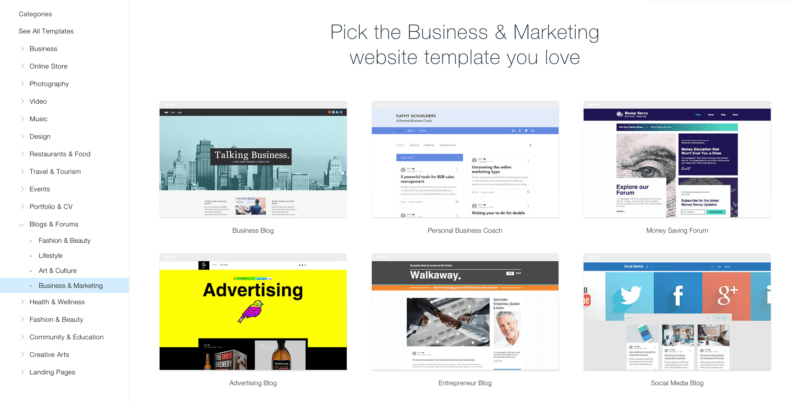
They have templates for music, art, fashion, health, travel, photography, construction, and restaurant sites—just to scratch the surface.
Wix also offered numerous revenue streams for one user we talked to.
“My Wix website got me a few jobs,” they told me. “I’m also making consistent monthly income because of an online store I built on my site.”
Even though Wix offers a user-friendly website builder, it also gives you a comprehensive knowledge base of articles you can use if you ever get stuck.
“If I’m unsure about a certain topic, it’s quick to find answers via their support,” one user told me.
If you need a little bit more hands-on help, Wix offers a 24/7 callback service for US-based users so an actual person can walk you through any issues.
That’s a rarity in the website builder world—and definitely something that’ll help you in the long run. That way, if something breaks or your website crashes, you can immediately call someone up to help you.
Of course, we wanted to test it out for ourselves, so we jumped in and created our own Wix page from scratch.
Building a Website with Wix
When we set up our Wix account, we was surprised to find that it actually gave us a few ways to create our own website.
First, we could get our hands dirty and choose a template and build our website from the ground up.
Or, we could simply answer a few questions about the type of website we wanted to build, and Wix’s ADI builder would handle all of the work for us. We had a decent-looking site after just a few answers.
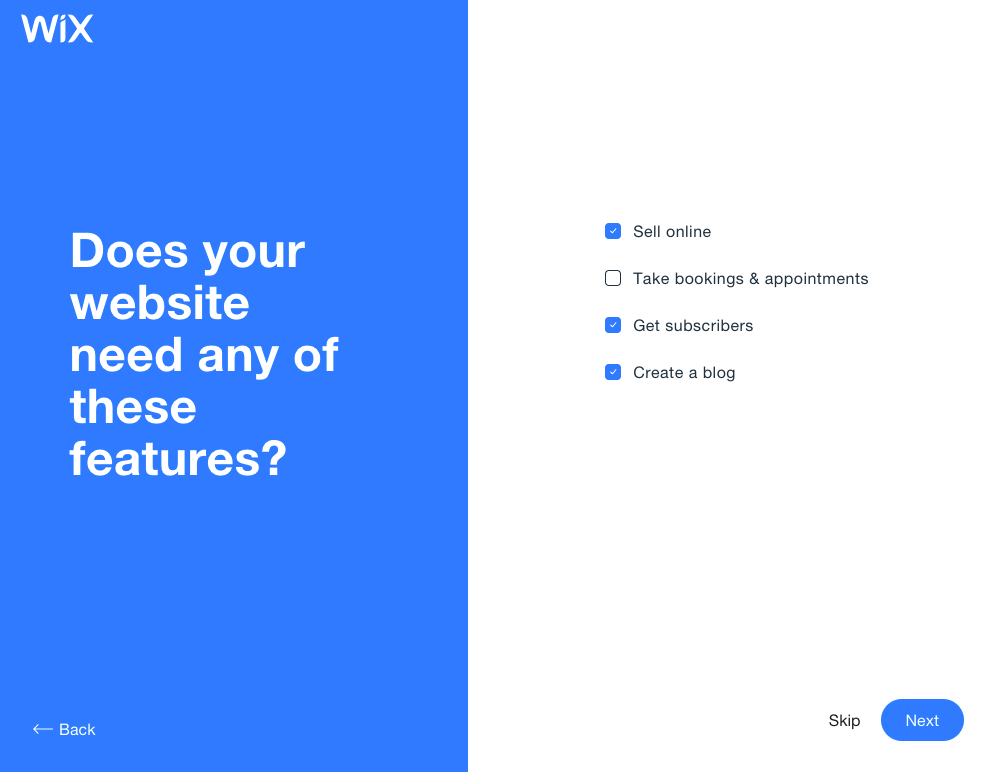
Once you pick a template, you can update everything from the font, logo, and colors to images and more. That means you can make any of the already great-looking templates all your own with a little bit of tweaking.
When we tested Wix, we loved how easy it was to find a template that matched our vision. The AI stayed with us as we edited the page, helping to pick the next thing to edit and explaining how to do it.
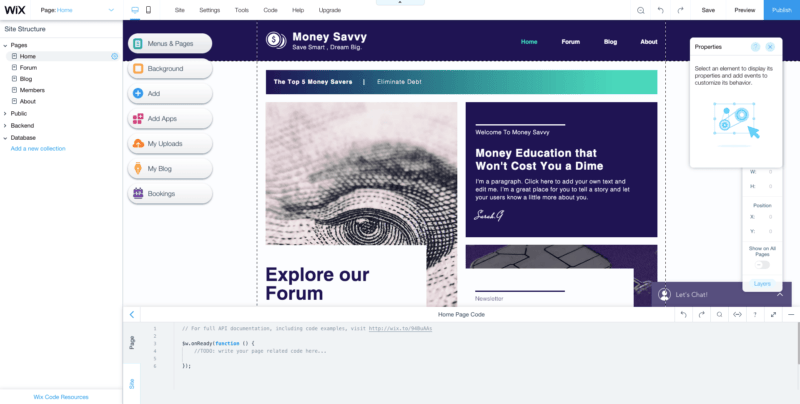
The Wix AI matched our new site to existing social media accounts, used our logo to create a color palette for the site, and provided a template pre-populated with that logo and our street address. Connecting images from existing social media accounts made it easy to pull in all the assets we already owned.
Pick a business you already know and see how close Wix’s AI comes to replicating it. We used a local yoga studio as an example, and Wix did closely match the studio’s existing site. Even better, the studio probably paid a web designer for their design while we did ours for free with an AI assistant.
Tradeoffs With Wix Website Builder
Take note: all of Wix’s plans are automatically set to auto-renew. Sticker shock is real, especially if you signed up with an introductory promo pricing. As one of our users put it, “the price per month tends to be quite high.”
That can be a big deal if you’re, say, a scrappy startup trying to make and save as much as possible. If you want to recoup some of the expenses with an ecommerce site, you’ll still have to pay for a more expensive plan for the subscription fee.
Most of the users we spoke to did use Wix to build their own personal portfolios and blogs. That allowed them to find clients and customers.
Since Wix occasionally features their own users on their official blog, it can lead to more opportunities for you if you choose the platform. That’s exactly what happened to one of our users who said, “Being featured on Wix got me some freelance opportunities and ultimately landed my full-time job.”
Wix Pricing
Wix has a wide range of plan options to choose from—ranging from just the basics to get started all the way to advanced ecommerce and enterprise features.
- Light – $16 per month
- Core – $27 per month
- Business – $32 per month
- Business Elite – $159 per month
All plans are backed by Wix’s 14-day money-back guarantee. If you’re not 100% satisfied, they’ll provide a full refund.
Why We Recommend Wix
Overall, Wix offers the best combination of ease of use and customization of any platform we looked at. It’s not the cheapest, but people seemed really excited about the sites they were building.
The themes are varied and fantastic. You’ll also be armed with the tools you need to customize its look and feel to your exact specifications—or pretty darn close.
Wix gives you the option to essentially build your website for you through their AI site builder. That’s an amazing feature that no other website builder we reviewed offers. It takes the guesswork out of everything, especially if you just want to get a website up and running right away.
And if all that isn’t enough, Wix also delivers rock-solid security and reliability. It includes high-grade security compliance, 24/7 monitoring against cyber threats, a robust 99.98% uptime rate, ecommerce security measures that meet the highest industry standards, and worldwide data and backup centers to keep your site information safe and secure. So no matter what kind of website you build, you can sleep easy at night knowing it’s protected, without you having to do a thing.
Bottom line: Wix is a great website builder for beginners who want plenty of customization options.
Hostinger – Best for Keeping Website Costs Low
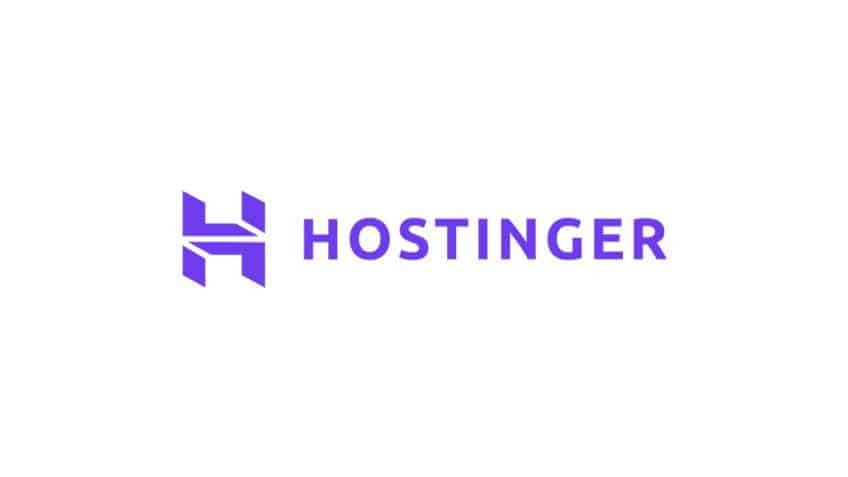
Hostinger is a great low-cost solution for anyone who wants to build and update a website on their own. There are only a few great website builders out there—this is one of the most affordable ones that doesn’t skimp when it comes to functionality.
You don’t need to learn how to code. You won’t have to hire a developer. You can just drag, drop, and click your way to an eye-catching website. And you’ll save a lot of money each year while doing all this.
If you’re a startup or freelancer that just needs a basic website, Hostinger should be at the top of your list. Is it as robust as some of the other heavy hitters on our list? Not quite. But it is exceptionally easy to use and comes in at a fraction of the price.

Will you make a few tradeoffs with Hostinger? Maybe, but when you’re just starting out and need a web presence to get things moving, you likely won’t even notice anything missing.
When your budget is small, there’s no easier way to build your website than Hostinger.
Building a Website with Hostinger
Simple and low cost don’t usually go together when it comes to website builders. But Hostinger does both with ease. It was already one of Quick Sprout’s top picks for affordable web hosting companies.
Now it has added website building to the mix, so you get the best of both worlds—affordable hosting services and a very easy-to-use website building experience—all for one low monthly price.
This is what makes Hosting so attractive. A total beginner can jump right in and have a functioning website up and running for just a few dollars each month.
We interviewed a Hostinger user who needed a professional-looking website when she started her freelance writing business. She wasn’t technically inclined but noted that Hostinger is “great for anyone intimidated by the web.”
It took her under 24 hours to build her site with Hostinger. “This is your confidence builder,” she said, adding that the process is “very, very intuitive.”
When you design your site on Hostinger, nothing is left to chance. The drag-and-drop functionality means great design is just a few clicks away. Plus, pages are automatically optimized for mobile or desktop, so your site looks great on every device with no extra work on your side.
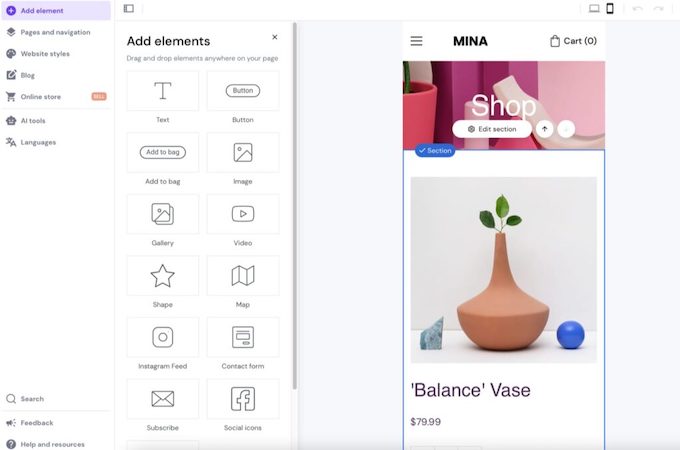
You don’t have to start from scratch, either. Hostinger includes more than 100 professionally designed templates ready for you to customize. So if you really want to simplify things, just choose a template, fill in the blanks, and have your site up and running in a few minutes.
But you’re never limited to out-of-the-box design. There are tons of elements you can pick and choose to include on your site, including videos, links, maps, galleries, and color schemes. You just pick what you want and apply it to your site. No CSS or HTML efforts are required.
While you can always go the WordPress plus hosting route to minimize costs, if you’re a beginner at website building, it will be more complicated to get your site looking the way you want. It will also likely require multiple plugins (some you may have to pay for) and tweaks to the code to achieve what you can automate with Hostinger web builder.
Hostinger includes basic tools that deliver fundamental website functionality, like creating contact forms, building landing pages, and scheduling blog posts. But there are some pretty in-depth features you wouldn’t expect to see at this price point.
The AI suite of tools has some of these advanced features. This gets you going faster by taking the guesswork out of adding key elements required for great website design and functionality.
- AI logo maker: design a unique logo by just answering a few questions
- AI writer tool: write copy that converts even if you’re not a writer
- AI heatmap tool: identify where people are (or aren’t) clicking, moving their cursor, or scrolling on your site

While some of this AI functionality still has room for improvement—like the AI writer tool—it is a start. And sometimes, a start is all you need to get your creative juices flowing.
The real benefit of Hostinger, though, is how it integrates basic website tools like SEO and image compression right into the platform. Even if you’ve never had to optimize an image or use SEO to improve your site’s Google rankings, Hostinger makes both easy to do.
And if you get stuck on anything, there are plenty of resources available on its website, plus 24/7 customer support to get you back on track. Hostinger customers seem satisfied with both.
“They’ll give you a canned response in some cases,” one user told us, but it “wasn’t a big deal” most of the time because the resource library on the Hostinger website is quite robust. Overall the customer service agents are “very, very helpful.”
Tradeoffs with Hostinger Website Builder
In terms of design, WordPress, Wix, and Squarespace will all give you more options than Hostinger currently offers.
So if you have a goal of designing an award-winning website that catches the attention of professional designers, you’ll probably be better served to go with one of these other options. Wix has hundreds more templates available and integrates with more online tools, too.
Another important thing to know is the concept of “template lock-in.” Some website builders, including Wix and Hostinger, don’t let you switch templates once you choose one.
To change your site template, you’ll have to copy everything over to a new template, which can be very time-consuming. If you think you’re going to want to change templates often, Squarespace or WordPress might be a better option.
Simplified drag-and-drop might also be a bit limiting for some aspiring website creators. If you really want to get granular with layouts and designs, something like WordPress might be a better alternative. Of course, that extra design power comes at a cost of being harder to learn and use.
Hostinger Pricing
Hostinger comes in as one of the most budget-friendly options on our list for a solid website builder. You can get started for just $2.99 per month, and that price includes both the website builder tools and website hosting.
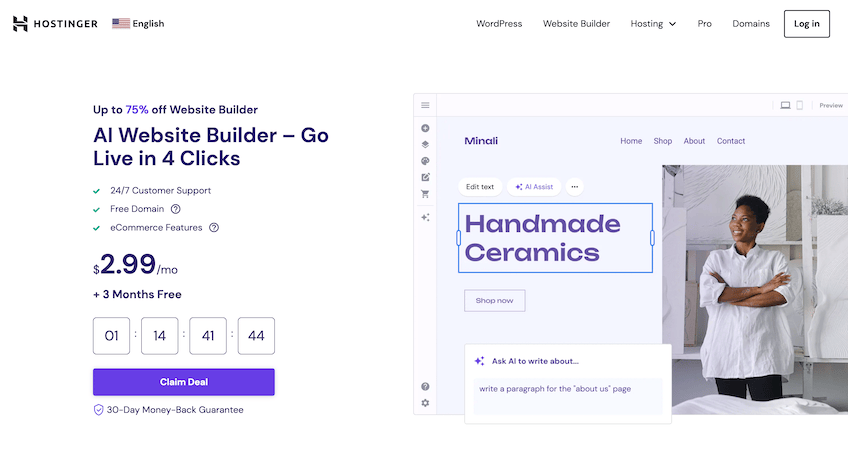
However, to get this price, you’ll need to sign up for a year or more. You’ll also have to pay upfront, which can be a bigger investment if you choose a multi-year option. But if you know you’re going to need a website for the long term, this tradeoff will save you a lot of money in the long run.
Why We Recommend Hostinger Website Builder
Hostinger is the best option for anyone who needs a low-cost, easy-to-use website builder.
You’ll pay less than the cost of one latte each month for a fast, reliable website. Need to change things on the fly? Announce a special sale? Share important information with site visitors? You can do it all yourself in just a few minutes.
If you’re committed to your website for a year or more, there isn’t much risk to signing up for a longer plan term and locking in the ridiculously low price for Hostinger website builder and web hosting services.
Hostinger gives you all you need to hit the ground running, even if you’re not savvy about building or maintaining a website.
Bottom line: Don’t spend more than you need to get an awesome-looking website for your business. Save up to 75% on Hostinger website builder today.
Squarespace – Best Website Builder for Creators
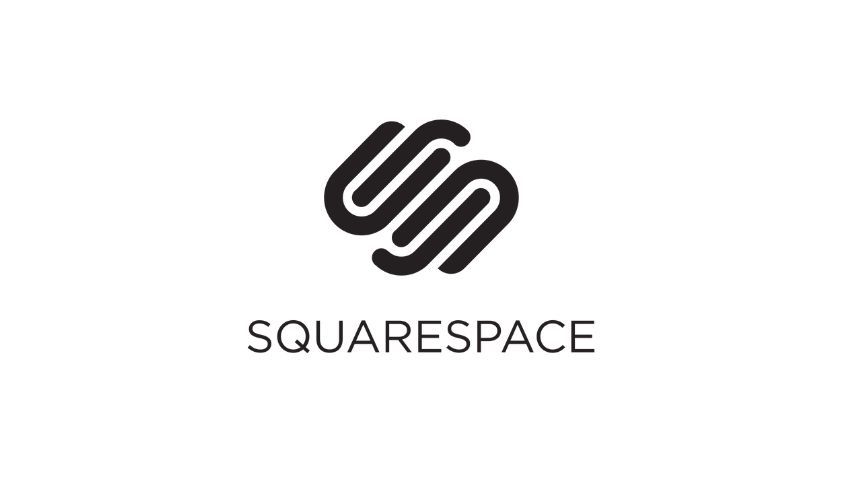
Squarespace has been the go-to choice for creative professionals and business owners who really care about the look and feel of their websites.
So you shouldn’t be surprised to learn that the Squarespace users we talked to had creator-focused websites. We spoke to a web design expert who teaches students how to create jaw-dropping sites and an interior design blogger who uses Squarespace to feature gorgeous home tours.
“I think I had my blog up and running within a day,” said one user. “Squarespace offers clean, beautiful templates you can easily tweak.”
Building a Website with Squarespace
Jumping in, we found that Squarespace does indeed give you an easy way to start a blog, just like Wix. However, we had to admit that as much as we liked Wix’s themes, Squarespace would take home the Best In Show ribbon for how gorgeous their themes looked.



Aside from the template selections, it’s also worth noting that the backend editor is user-friendly and intuitive.
This is ideal for beginners, like the newly graduated graphic designer that wants to build a portfolio or a photographer who wants to launch their first business website.
Squarespace is also a viable option for the new generation of influencers and content creators who are currently using platforms like YouTube or TikTok. Squarespace gives them a chance to expand their reach across multiple channels, and it even plays nicely with other platforms. This is especially useful for YouTube creators, making it easy to embed videos directly on your Squarespace site.
“They have a great What You See Is What You Get builder,” said one user. “That means when you’re building the page, you see what the page will look like as you’re building it.”
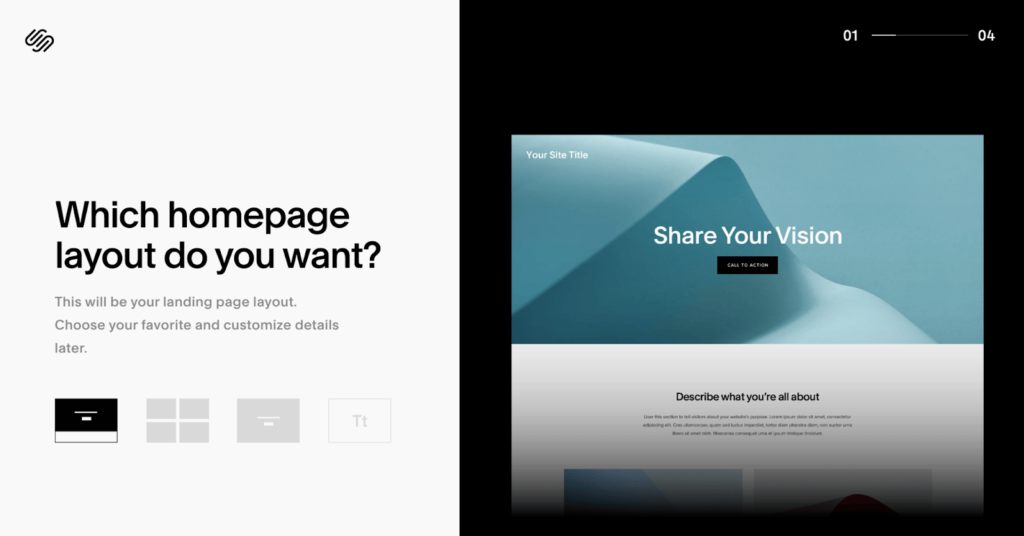
This is an area where site builders like Squarespace and Wix shine above WordPress. You can easily see the changes you’re making to your website as you’re making them. There’s no need to click back and forth between preview windows.
If you’re just starting out, this can make your life much easier. Even seasoned webmasters might see this as a breath of fresh air compared to alternatives.
“Sometimes, like in WordPress, you’re editing your site in the backend, but then you have to go to the front end to see what it’ll look like when you’re finished,” the user said. “With Squarespace, as you’re building the blog post, you’re seeing the changes happen at the same time. And I think that’s really useful. That’s one aspect that makes it easy to use.”
Tradeoffs with Squarespace Website Builder
While Squarespace ranks fairly high for its level of customization, this was still an area of some contention for our panel of interviewed and surveyed users.
One user enjoyed what Squarespace offered in terms of customization options and extra tools, such as an ecommerce function, integrated email marketing, and podcast support. However, they still found it fairly limiting when compared to the enormous customizability of WordPress. Not to mention, you might have to pay more for the plugins and widgets you need to make certain things work.
“Custom CSS is only available in the Business Plan,” said one user. “It’s doable for my website, I found some great tutorials on the internet for extra CSS customization, and I had to buy a sidebar plugin because it wasn’t integrated in my template. For more complex websites, this might be a problem.”
More specifically, the level of mobile customization is an area our users flagged. One user found it particularly frustrating, saying they essentially had to create your website twice—once for desktop and another time for mobile.
But, it should be noted that the Squarespace version you use might result in a different desktop vs mobile experience. For example, Squarespace version 7.0 might have templates that include extra built-in mobile styles that’ll make your site look different depending on what device you’re using to browse.
While the website builder is easy to use, it could certainly be more intuitive. This is an area where Wix has an edge over Squarespace. One user told us, “It could be more obvious how to perform certain actions. Sometimes you have to hunt and click here and there. Every now and then, I’ve accidentally deleted a blog because I’ve clicked the wrong button.”
Squarespace Pricing
Squarespace has four different website builder plans to choose from:
- Personal – $23 per month
- Business – $33 per month
- Commerce Basic – $36 per month
- Commerce Advanced – $65 per month
Save up to 30% when you sign up for annual billing. You can try Squarespace for free with a 14-day trial.
Why We Recommend Squarespace
Squarespace allows you to create an eye-catching blog or portfolio with ease. For people who want a million interactive features on their site, it might not be the best. But if you prefer a minimalist look or you really need to showcase images and videos–Squarespace should be your top choice.
The website builder’s gorgeous templates and creator-friendly features earned it a spot on our list. Their designs truly can’t be matched.
Bottom line: If you’re a creator looking to show off stunning visuals of your art, photographs, graphic design, and more, then Squarespace is the builder for you.
Weebly – Best for Solopreneurs
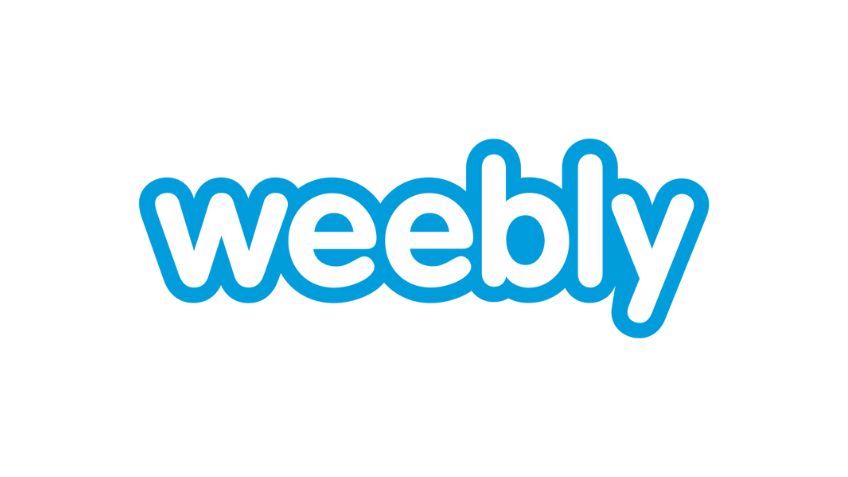
Weebly is another flexible, out-of-the-box website builder in the family of Wix and Squarespace. We like it for freelancers and solopreneurs who need a website and a simple way to charge for their services.
Weebly is powered by Square—the folks behind the popular point-of-sale system. That means if you sell products in person, like at a farmers’ market, you’ll be able to easily integrate your POS sales with your website.
For ecommerce, it’s hard to beat Shopify–but if you don’t want a full online store, Weebly may have what you need.
We talked to users that ranged from a musician who used Weebly to sell music directly to fans to a LinkedIn coach and blogger who sold her coaching services via sessions directly on her website to a website designer who used her Weebly site to bring in new clients.
“I chose Weebly to design all of my websites years ago with the idea that it was simple enough that my clients could update their own websites,” said the web designer.
Building a Website with Weebly
After hearing our users glow about Weebly’s easy site-building process, We had to jump in for ourselves.
True to their word, our users were right when they said it was easy. Weebly offers an intuitive website creation process. It is as simple as choosing a domain name and a template and creating the site.
It’s also easy to add new pages to your website. One of our users told us, “Creating the blog section of my website was super simple and took less than five minutes to set up.”
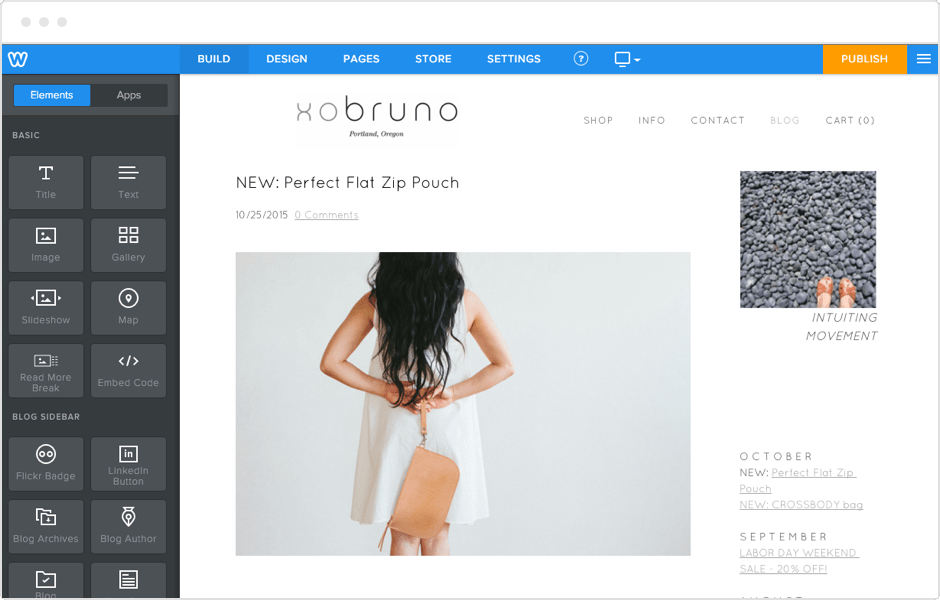
Weebly integrates nicely with other third-party tools that you’ll definitely want for your website such as Google Analytics and Mailchimp.
The builder itself is drag-and-drop a la Wix or Squarespace. So like those platforms, it’s minimal effort and headache free. What you see is what you get.
There are tools for email, SEO, site analytics, shipping, and inventory for the ecommerce plan. You’ll be able to even add a product search to your online store—which we love. If you have a big catalog of products and services, you’ll definitely want to add this function in.
They also give you the ability to add badges to your products and services when they go on sale or when inventory is low for a specific item. That’s a great way to build scarcity into your products—and make your customers want to click the buy button all the more.
Setting it up is simple and straightforward too. Since it’s a WYSIWYG builder, we can easily swap out products, prices, and descriptions, along with digital assets like logos, product images, and banner images. Setting up a rudimentary store took less than five minutes to do after signing up.
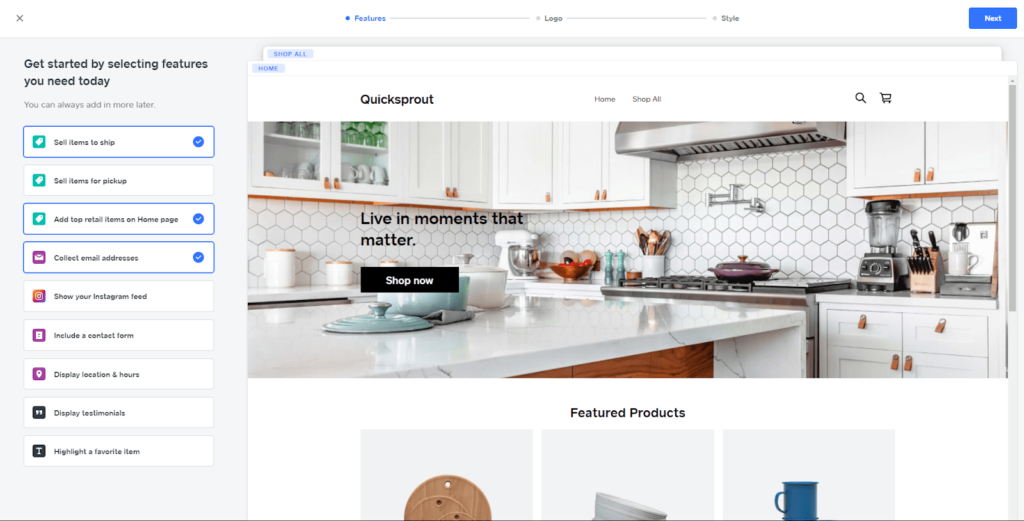
We were also pleased by the ability to accept payments via gateways like Paypal, Stripe, and—of course—Square. Those options are a boon for users who will be able to pick the gateway they want.
Tradeoffs with Weebly Website Builder
One of our users didn’t like how Weebly doesn’t allow you to “save” changes on your site before it goes live. That would be a good addition if you were in the process of redesigning your site.
Another user we spoke to didn’t like how complicated it was to sync up their inventory between their Weebly website and their Square POS system.
“Square and Weebly sometimes don’t cooperate with me or each other,” the user said. “So I can’t have full, accurate inventory reflected between the two entities.”
That user also opined the fact that they had to jump back and forth between Square support and Weebly support if they needed help fixing an issue. It’s like a game of tennis, and you’re the ball.
“If I want to fix something and I go to Weebly, they go, ‘No, go to Square,’ and Square’s like, ‘No, you have to go back to Weebly.”
Weebly Pricing
Here’s a quick overview of Weebly’s plans and rates for its website builder:
- Free – $0 forever
- Personal – Starting at $10 per month
- Professional – Starting at $12 per month
- Performance – Starting at $26 per month
The free forever plan is fine if you’re just getting started and want to test the platform. But we recommend the Professional plan. It’s just $2 more than the Personal option, but it’s packed with additional features.
Why We Recommend Weebly Website Builder
Weebly offers users a very simple website design experience with the ability to sell goods and services.
We’d point most ecommerce users to Shopify, but freelancers, consultants, and solopreneurs with a simple suite of services may want to check out Weebly.
Like Squarespace, Weebly also lacks the comprehensive customization and scalability of WordPress. But, on day one, Weebly is a lot more approachable than WordPress.
Bottom line: If you are running your own business, Weebly works off the shelf.
GoDaddy – Best for Building a Website from Your Phone

On top of the solid domain and hosting services, GoDaddy offers a simple and straightforward website builder.
It’s not necessarily the best at any one area—but think of it as “jack of all trades, but master of none.” From ecommerce websites to blogs to portfolios, they have tons of different templates to help you create the website that’s right for you.
If there was one single thing that GoDaddy does well, though, that’s intuitiveness and simplicity. That was the biggest standout for Gabriel Smith, one of the users we spoke to. In fact, Gabriel built his GoDaddy website all from his phone while he was homeless living on the street.
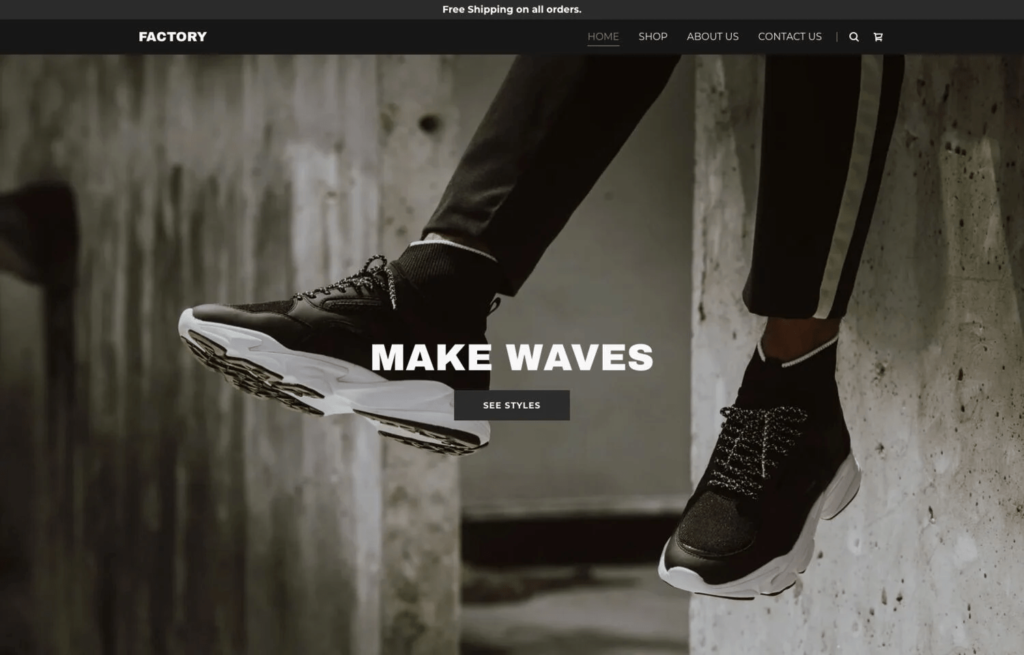
You read that correctly. He had just finished his memoir, also from his phone, and wanted to get his words out there. So he found GoDaddy and got to work building an entire website from his phone.
“I literally did it because I was homeless,” Gabe told me with a laugh. “What else could I do? Some way, somehow, I was going to get my story out because I didn’t know how many people that could possibly help.”
Gabe was able to easily create his website using one of his few possessions: a smartphone. Using just the mobile editor, he was able to create a website that worked for him and his goal of promoting his book.
In his own words, he ranks GoDaddy’s ease of use at a five “only because ten isn’t an option.” So simplicity is definitely a strong suit for the website builder.
With some more hustle and grit, Gabriel was able to secure speaking engagements because of his book and website, as well as coaching opportunities to help out folks who were in a similar situation to him. Now, he has a successful career as a motivational speaker and a self-improvement author.
Building a Website with GoDaddy
We tried it out and found that Gabe was correct. GoDaddy offers an intuitive way to create a website via a mobile editor or a desktop site builder.
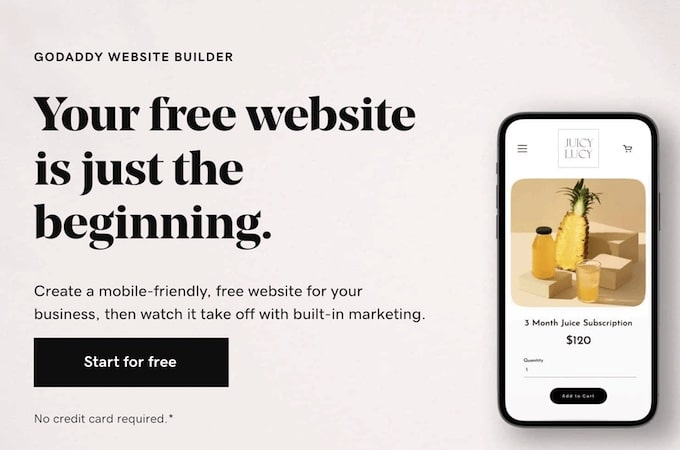
That’s not to detract from Gabriel’s immense accomplishment of building a successful website on his own while homeless, mind you—just verification that it is, in fact, easy to use.
We like that it gives you tools to book appointments, sell different products and services, and take reservations. Their drag-and-drop website builder makes it easy to do so too.
One user we spoke to owns a gardening shop and regularly offers classes. They said that they like the way GoDaddy “easily integrates appointments and workshops into the site.”
Our entire user panel of users also liked the tools offered—but occasionally wanted more. One user who owns a coffee roastery said they were “able to build an email list with our Godaddy website, which is an extremely effective way to grow, but outside of that, the growth tools were limited.”
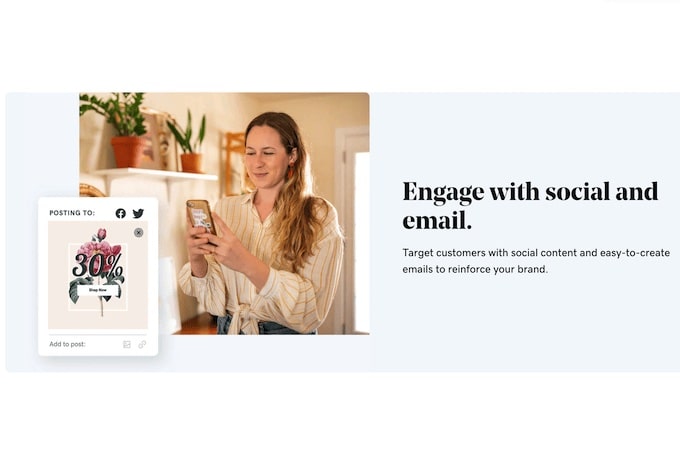
The simplicity is a boon and a drawback (as we’ll get into shortly). But overall, we enjoy it because of how easy it is to use.
It’s pretty affordable, though, with plans starting at $9.99 a month. We highly recommend it if you are already using GoDaddy for your domain or web host.
Cons of GoDaddy’s Website Builder
GoDaddy does seem to trade off simplicity for depth of customization.
In fact, they’re too simple in some ways. One user said that while the drag-and-drop editor was easy to use, it’s still “quite limited, and you can’t easily alter things like font size.”
That user also criticized how slow the editing tool becomes if you have too many digital assets on the page.
Also, if you’re hoping to direct your emails to a portal of your choice, it’s going to be tough. “I think my biggest issue with them is their webmail that’s tied to the website,” one user said. “After a very frustrating season of my emails to customers constantly getting stuck in spam filters, I had to give up and switch to Gmail for all correspondence. GoDaddy has not been able to fix the issue.”
They continued, “It’s a bummer because I’m paying for the service, and I want to have that professional email address, but I just can’t use it and have confidence that it will get to my customers.”
Another user actually recently switched from GoDaddy to WordPress because they felt like they had to “compromise on some aspects” of their website when building with GoDaddy.
“I wanted a store list of the physical locations people could buy our [products]. This didn’t exist,” said one user. They ended up having to get creative with a menu tool to create this page—but it obviously wasn’t ideal.
The user also added, “The lack of ability to have recurring purchases for our [product] subscription service was also a big factor in deciding to switch from Godaddy to WordPress.”
GoDaddy Pricing
GoDaddy offers four different website builder packages to choose from:
- Basic – $9.99 per month
- Premium – $14.99 per month
- Commerce – $16.99 per month
- Commerce Plus – $29.99 per month
You can try GoDaddy’s premium features for free with a seven-day trial—no credit card required. If your trial expires and you haven’t signed up, you can always upgrade at a later time without losing the work you’ve started.
Why We Recommend GoDaddy Website Builder
If you’re looking to build a website easily and quickly and don’t expect to upkeep it too much, GoDaddy could be a good choice for you.
It’s a fantastic alternative if you’re a busy, on-the-go professional or someone who might be limited in the ways they can create their website looking for a dead simple website builder to get the job done.
In any case, Gabriel is more than happy to tell you how happy he is with GoDaddy—and that makes it a fantastic choice.
Bottom Line: GoDaddy offers a simple, easy website builder—but not much else.
How We Chose Which Products to Review
We chose all seven website builders based on four criteria:
- Ease of Use
- Depth of Customization
- Scalability
- Ability to Earn Money
We took a look at dozens of the most popular website builders on the market today and benchmarked each of them against the three qualities above.
For each website builder found, we created a bare-bones website to test out its tools and features. We also took into account the things offered in paid premium plans.
Using this method, we were able to narrow down our list of more than a dozen website builders to the seven best. These seven best showcased the three criteria above in unique—but effective—ways.
In all, this stage of the research process took two weeks to complete. When we finished, it was time to find real users of each product.
How We Reviewed Each Product
At Quick Sprout, we believe that if you want to get actual insights about a product or service, you need to talk to actual users.
You can’t just trust the website builder’s marketing or even the testimonials you find on review sites. Instead, you need to find the people who have used the builders before. Only then can you get the good, the bad, and the oh-so-frustrating.
It took time to find and verify users, but in the end, we were able to connect with a few dozen people that used these website builders for their businesses.
Each person agreed to either a phone interview or a survey. Questions for both were identical, though some of our interviewees had a lot to say about their experience.
We took all of our research, interviews, and surveys and synthesized them into the post you are reading now.
What We Learned Choosing the Best Blogging Platform
There’s no such thing as a “perfect” website builder. Instead, each one offers a unique set of features and tools for a different kind of user.
Everyone wants something easy to use, but what exactly does that mean when it comes to website builders?
Keep reading to hear insights from our research and user interviews that can help you hone in on a website builder that really matches your needs.
Ease of Use
If you’re reading this, you’re likely a beginner. We all need to start somewhere.
What that means is that ease of use plays a bigger role in your ultimate decision than ever.
The reason is that it’s easy to get frustrated and burned out when learning a new skill like website building. That can easily result in abandoning your website-building efforts entirely.
To combat that, you want to make things as easy as possible in the beginning. That’s why we highly recommend finding a platform that can help you create a site easily and quickly.
While building a WordPress website isn’t the easiest route, it’s still relatively easy to understand. Especially if you use Bluehost. It’s beginner-friendly onboarding process guides you through every step so you don’t have to figure out anything on your own.
Plus, by using WordPress, your new website will be portable (you can change hosts or move it wherever you want later), you’ll get more customization and flexibility, and you’ll spend less than you would with other builders.
However, if you want the absolute fastest and easiest route, there are other options.
With something like Web.com, a first-time user is not going to run into any trouble. We really love that it will hold your hand through the process—and will even build out the website for you if you want.
That said, Wix, Squarespace, Weebly, and GoDaddy are also easy-to-use products as well. It just depends on what you’re looking for.
For example, if you’re looking for a great WYSIWYG website builder to create gorgeous blogs and portfolios, Squarespace has some of the best templates we’ve seen, straight out of the box. If you want to create an online store, Shopify is a great option.
Depth of Customization
Being able to customize your website to the exact look and feel you want is crucial—but it sometimes makes the learning curve for the builder a bit steeper.
This is a delicate balancing act. But once you strike it, the platform will allow you to not only align with your brand but also draw in the type of readers and customers you want.
Customization also includes things outside of the way your website looks. It’s also the ability to add the features you need to accomplish your goals.
For example, if you want to build a list of email subscribers for a newsletter, you want to find a website builder that’ll allow you to easily capture your visitor’s contact information. For that, you might want to go with Wix, Squarespace, or Bluehost and WordPress, as they give you either native tools to do so or allow you to download a third-party plugin like Mailchimp.
Not all platforms offer the same amount of customization. A website builder like WordPress offers the deepest level of customization on this list. You’ll be able to create the exact website you want so long as you have the knowledge to code and edit or are willing to pay someone to do so.
A website builder like GoDaddy offers likely the least amount of customization. That’s not to say you won’t be able to build a good website. They’re just not open-source. As such, there’s no community out there dedicated to creating widgets, plugins, and themes for GoDaddy sites.
A builder like Squarespace allows you to include things like ecommerce stores easily right out of the box.
“One of the reasons why I recommend Squarespace to small businesses or bloggers is because you don’t need to go get a third-party plugin to add a shop or to have your Instagram in the footer or create your email newsletter collection,” said one of our users. “It’s really an all-in-one system, which is wonderful.”
It all starts with the templates that they give you. You start with a theme but are able to use it as a launching point. Once you tweak and customize it to your specific needs, it becomes virtually whatever kind of website you want it to be.
Scalability
One often overlooked factor in choosing a website builder is scalability.
When you’re signing up for a website builder today, you may not be thinking about what your site will look like in one year, two years, or five years down the road. But this is something that absolutely must be taken into consideration, as it will save you a ton of time and headaches in the future.
Here’s what we mean.
Let’s say you’re just building a small personal portfolio site right now as a way to showcase some of your photos or artwork. So you find a website builder that allows you to do just that. But next year, you might want to add a blog. The following year, you might decide to start selling photography and artwork online and need ecommerce features like product pages and payment methods.
If you don’t plan for scale today, you might be forced to switch website builders in the future to accommodate new goals and initiatives. Fortunately, all of the website builders featured in this guide are built to scale. For example, Squarespace will let you start with a basic site, then upgrade your plan when you want to ecommerce functionality. If you’re using Bluehost, you’ll be able to extend the functionality of your WordPress site without limitations by simply installing new plugins.
Ability to Earn Money
If you’re building a website for your business portfolio, or even a simple blog, you likely want to make money from it.
Websites are marketing channels, after all. They exist to promote brands, products, services, movements, and more.
The website builder you choose will have a fairly big impact on how much money you can earn.
For example, if you want to build a good ecommerce store, we would highly recommend going with Shopify. It’s a true plug-and-play ecommerce website builder that works across every sales channel.
Weebly is partnered with Square—which makes it a cost-effective way for people to start selling from their site.
But online stores aren’t the only way to make money.
For people looking to drive traffic to their site for advertising purposes, Shopify is not going to work out well at all. WordPress is probably a much better choice for that. They offer a ton of great third-party plugins to help with SEO.
Sure, you won’t have an out-of-the-box ecommerce functionality. But WordPress gives you a much higher ceiling in terms of being able to customize your website and creating even more avenues to revenue beyond sales.
Best Website Builder: Your Top Questions Answered
The Top Website Builders in Summary
There’s no one-size-fits-all solution for website builders. What works for one person or business might not work for you—and that’s okay. Look for a website builder that addresses your needs and skill level. Start with a template, and you’ll be on your way.
Use the recommendations in this guide as a resource as you’re evaluating the best website builders. Our reviews still steer you in the right direction.

